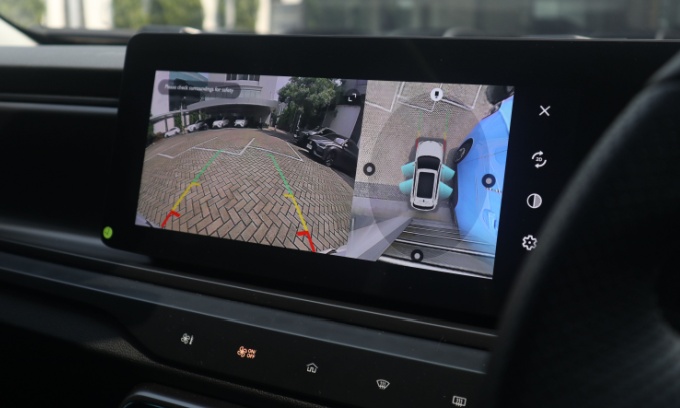KEY POINTS
- All vehicles driven on Australian roads are legally required to have functioning seatbelts.
- Some car safety features may help you avoid road accidents, as well as other accidental damage.
- Just like aesthetic features, the most advanced car safety features will usually add to the price of a car.
What car safety features should you look out for?
Car safety features can vary depending on the make, model and age of the car you’re looking at buying. Some newer models can come with all the below features, whereas some older vehicles may only have the essentials. Here is our list of some of the car safety features you may come across when buying a vehicle:
1. Electronic Stability Control (ESC)
Have you ever lost control of a car and fish-tailed? It’s frightening, not to mention potentially fatal. If this happens, Electronic Stability Control (ESC) detects when your tyres lose traction and takes steps to help you regain control, either by applying the brakes to spinning wheels or reducing power, or both.
ESC became standard in the early 1990s and it’s important to not turn off or disable the ESC button. If you’re buying an older car, it’s advised to buy one with this important feature.
2. Lane departure warning
This technology lets you know if you’re literally “crossing the line”. It’s generally a camera-based system that monitors the car’s position by observing the line markings on the road. If the vehicle wanders outside their lane, an electronic observer will trigger an audible, visual or haptic warning and get them back on the right path.
A further advancement is Lane Keeping Assist—a proactive system which actually manipulates the steering to prevent you from veering outside your lane. In some new cars, the feature is quite strong and can feel like you’re wrestling against your vehicle, which is purposefully designed in this way to combat driver distraction and fatigue.
3. Active Cruise Control
Active Cruise Control (sometimes called adaptive cruise control) is a little like Lane Keeping Assist in that it takes a little getting used to. Once you have set Cruise Control, this feature detects the distance and speed of the vehicle in front of you and maintains a safe following distance. For example, if you set Cruise Control to 100km/h, and the car in front of you slows to 90km/h, Active Cruise Control will override your setting and automatically slow your vehicle, too. And if the car in front speeds up again, your car will too. This is particularly handy for highway driving. It’s worth noting that Active Cruise Control will not exceed your chosen speed though, even if the car in front does.
4. Tyre pressure monitoring
Checking your tyre pressure is probably one of the least thought of practices when it comes to at home maintenance. But did you know properly inflated tyres add greater stability, handling and braking efficiencies? Conversely, under-inflated tyres can contribute to accidents in several ways: they reduce a vehicle’s handling ability, they increase the car’s braking distance and they can lead to tyre blowouts.
Pressure monitors detect when a tyre drops below the designated pressure and alerts you. There’s also an economical benefit to this technology as under-inflated tyres increase fuel consumption and shorten a tyre’s lifespan.
5. Pedestrian Auto Emergency Braking
Auto Emergency Braking (AEB) helps a car to independently brake, if a crash is imminent. Advanced systems may then tense seat belts, adjust seat positions to improve airbag performance and shut open windows to prevent passenger ejection.
This detection technology has even been fine tuned to include pedestrians. It uses cameras and radars to detect vulnerable road users through their shape, movement and characteristics. The way a pedestrian moves in relation to the path of the vehicle is calculated to determine whether they’re at risk of being hit. If the situation is critical, the brakes will be applied independently of the driver.
Compare car insurance policies
If you’re comparing car insurance policies, the comparison table below displays some of the policies currently available on Canstar for a 30-39 year old male seeking comprehensive cover in NSW without cover for an extra driver under 25. Please note the table is sorted by Canstar Star Rating (highest to lowest) followed by provider name (alphabetical) and features links direct to the providers’ websites. Consider the Product Disclosure Statement (PDS) and Target Market Determination (TMD), before making a purchase decision. Contact the product issuer directly for a copy of the PDS and TMD. Use Canstar’s car insurance comparison selector to view a wider range of policies. Canstar may earn a fee for referrals
- Save 15%^ on your first year’s premium when you purchase a new Car Insurance policy online.
- 24/7 Phone & Online Claims.
- Budget Direct - Insurance Solved.
- Insurance that's a bit more you-shaped.
- Canstar’s 2025 Most Satisfied Customer Car Insurance – NSW, VIC, SA
- Lodge a Claim 24/7 with our Advisors
- Flexible cover before, 24/7 claims after.
- Save $75 on new Comprehensive car insurance online.
- Conditions apply.
- No age-based excess.
- No excess on your first covered windscreen repair.
- Canstar 2025 Outstanding Value Car Insurance Award.
- Collect 10,000 Flybuys Points with a new Comprehensive Car Insurance Policy for Flybuys members. Ends 30/1/26. T&Cs, Excl Apply.
6. Reversing cameras and automatic parking systems
Gone are the days of looking over your shoulder when reverse parking, as many new vehicles now come with reversing cameras. Outside of helping you park, these cameras may even be able to help you avoid reversing related accidents. Using a monitor in the cabin and a rear-facing camera, this car safety feature gives you a clear rearward view and can detect cars, people or objects in the way of a reversing vehicle.
Newer systems may provide impressive large, clear screens, parking guidance lines and even a bird’s eye view from above so you can see your car in relation to surrounding vehicles. There’s also automatic parking assist which can help you park all with the push of a button. All you have to do is find a suitable parking spot and the vehicle will steer itself into it while you control the accelerator and brake.
7. Headlights and windscreen wipers
Headlights are one of the oldest car safety features, going back as far as the late 1800s. They serve two purposes while vision on the road is obstructed (i.e. at night, in fog, during storms etc.): to help you see the road ahead and to let other road users know that you’re there. Advances in lighting technology have also made fog lamps and Daytime Running Lights (DRLs) commonplace. As the name suggests, DRLs remain illuminated throughout the day in order to improve visibility and may adjust themselves automatically as light changes.
Some vehicles may also come with auto dimming headlights. The road rules stipulate that you must dip your headlights to low beam when a vehicle coming toward you is within 200 metres or when you’re driving 200 metres or less behind another vehicle. Auto dimming headlights do this job for you. Sensors detect an oncoming vehicle and will switch off your high beams when you’re within this distance and turn them back on when it’s safe to do so.
There’s also been advances in the technology surrounding the light source of a vehicle’s headlamps. Newer vehicles may come with high-intensity discharge (HID) technology, which gives off brighter light than a traditional headlight globe, or LED technology, which promises to offer smarter beam patterns for differing road conditions. Some LED headlights may even be able to be directed away from oncoming vehicles without reducing overall brightness and visibility.
Going hand in hand with headlights are windscreen wipers. They function by removing liquids and debris from your windscreen in order to increase your visibility of the road. Some newer cars may come with automatic wipers which can detect moisture in the air and on the windscreen, as well as debris.
8. Crumple zones
New vehicles are designed to have crumple zones in order to better protect you and your passengers. These zones work almost like a safety shell, as they crumple on impact and absorb crash energy within the outer parts of the vehicle. This way the bulk of the damage is dealt to the structure of the vehicle itself rather than to the passengers inside.
9. Indicators, mirrors and blind-spot monitors
Similar to your vehicle’s horn, indicators act as a warning to other motorists of your intentions on the road. As a basic safety feature, indicators haven’t really changed all that much since they were introduced in the late 1930s. The same can be said for your vehicle’s mirrors.
The rearview and side (wing) mirrors serve to give you a better view of your surroundings while driving and eliminate your blind spots. Many new vehicles also come with blind spot warning systems. These systems detect and alert you when vehicles or other objects enter your blind spot/s.
10. Shatter-resistant windscreens
When windscreens were originally introduced in vehicles, they only really served to protect the driver and passengers from the wind and flying insects. If a collision occurred, the windscreen would break into shards of glass, potentially further injuring the vehicle’s occupants. Modern windscreens, however, are built with two layers of laminated, shatter-proof glass with a layer of plastic in between. This helps the windscreen stay intact when it breaks. Car windows may also be shatter resistant in a sense as well, usually breaking into large pieces which are less likely to injure you or your vehicle’s occupants.
11. Anti-Locking Braking System (ABS)
Like the name suggests, anti-locking brakes (ABS) prevent a vehicle’s wheels from locking up when braking. This means you still have the ability to steer, which can be very useful when driving on wet and slippery surfaces. ABS also detects the rotational speed of individual wheels on a vehicle and can release hydraulic fluid if a wheel is rotating too slowly. ABS has been the standard braking system since the 1980s.
12. Seatbelts
A universal car safety feature, the seatbelt has been around since the early 1900s, with the standard three-point, Y-shaped design that we know today being patented by Volvo in 1959. Nowadays, seatbelts can be found in trucks, buses and even aeroplanes.
The three-point seatbelt design, now standard in all cars, is effective at dispersing the force of a moving human body during a collision. Seatbelts that automatically tense on impact are also available in many new vehicles. All cars driven on Australian roads are required to have seatbelts and failing to wear one as a driver or passenger could attract penalties such as fines or demerit points.
13. Airbags
First constructed in the 1950s, the airbag gained traction as a car safety feature in conjunction with the three-point seatbelt. However it wasn’t until the late 1990s that airbags became mandatory in all vehicles. Designed to cushion a vehicle’s occupants during a collision, airbags are generally located in the steering wheel and dashboard near the front passenger seat. Some newer vehicles may also have side airbags in car doors or seats, curtain airbags in the lining of the vehicle’s roof and knee airbags underneath the dashboard.
14. Head restraints
Although they may provide comfort when driving or sitting in a car, head restraints (also known as head rests) also serve as an important safety feature. In a collision, head restraints can reduce the chances of injury, especially from motion related injuries like whiplash. Head rests are standard in all vehicles and experts recommend that the top of the head rest be positioned at or near the top of your head and as close to the back of your head as possible to have the maximum safety benefit.
Compare car insurance policies
If you’re comparing car insurance policies, the comparison table below displays some of the policies currently available on Canstar for a 30-39 year old male seeking comprehensive cover in NSW without cover for an extra driver under 25. Please note the table is sorted by Canstar Star Rating (highest to lowest) followed by provider name (alphabetical) and features links direct to the providers’ websites. Consider the Product Disclosure Statement (PDS) and Target Market Determination (TMD), before making a purchase decision. Contact the product issuer directly for a copy of the PDS and TMD. Use Canstar’s car insurance comparison selector to view a wider range of policies. Canstar may earn a fee for referrals
- Save 15%^ on your first year’s premium when you purchase a new Car Insurance policy online.
- 24/7 Phone & Online Claims.
- Budget Direct - Insurance Solved.
- Insurance that's a bit more you-shaped.
- Canstar’s 2025 Most Satisfied Customer Car Insurance – NSW, VIC, SA
- Lodge a Claim 24/7 with our Advisors
- Flexible cover before, 24/7 claims after.
- Save $75 on new Comprehensive car insurance online.
- Conditions apply.
- No age-based excess.
- No excess on your first covered windscreen repair.
- Canstar 2025 Outstanding Value Car Insurance Award.
- Collect 10,000 Flybuys Points with a new Comprehensive Car Insurance Policy for Flybuys members. Ends 30/1/26. T&Cs, Excl Apply.
Are car safety features worth it?
While having all the newest car safety features may increase the cost of the vehicle you’re looking to buy, you can’t really put a price on your own safety or that of your passengers. Not only can the above features help to keep you safe on the road, they may also help you to avoid road accidents, as well as accidental damage to your vehicle.
Accidental damage to your own vehicle can be quite common and is generally only covered by comprehensive car insurance policies. You may be covered for this type of damage under Third Party Property Damage and Third Party Fire & Theft policies as well, but only for the damage you cause to another person’s vehicle or property. By utilising certain car safety features, you may be less likely to need to make a claim on your car insurance. This means you won’t have to pay your policy’s excess or potentially lose your No Claims Bonus or Safe Driver Discount—which can help you save on your car insurance premiums.
It’s worth keeping the above car safety features in mind when buying a car. If you’re looking to finance the purchase of this vehicle, you can compare car loans with Canstar. If you’re also in the market for a new car insurance policy, you can also compare car insurance with Canstar.
When comparing loan and insurance products it’s important to read any relevant documentation, such as the Product Disclosure Statement (PDS) and Target Market Determination (TMD), before you apply.








